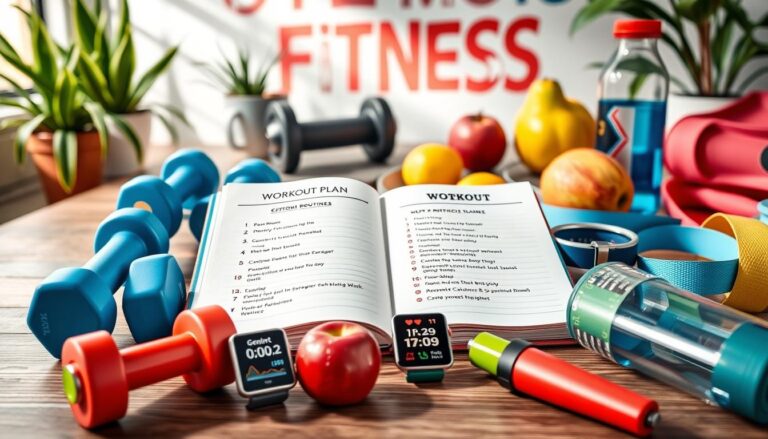10 Tried-and-True Full-Body Routines for Strength
Do you think real strength needs a long list of hard exercises? This article asks you to think again.
Here are ten proven plans that work every major muscle group. Each routine uses simple moves to boost both power and endurance.
Key Takeaways
- Compound lifts engage multiple muscle groups at once.
- Full-body training suits beginners and experienced lifters alike.
- Simplicity often leads to lasting strength gains.
- Steady progression prevents plateaus and injuries.
- Recovery plays a vital role in muscle development.
Understanding the Basics of Full-Body Strength Training
Looking for a way to work out every major muscle group in one go? This method can help your muscles grow faster and make the most of your gym time.
“Focus on multi-joint exercises that challenge several areas of your body at once,” suggests the National Strength and Conditioning Association.
This approach can also improve your endurance and keep your core stable.
Key Compound Movements
Movements like squats, deadlifts, bench presses, and overhead presses are key. They work many muscles at once, adding intensity to your workouts. Beginners often see big gains in strength by focusing on these exercises.
Common Mistakes to Avoid
Some people rush through exercises, ignoring proper form. This can hurt your joints and lessen the workout’s benefits. Others do too much too soon, without enough rest. This can slow progress and lead to burnout.
Creating a careful plan and pacing yourself helps you stay on track. It also lowers the risk of injury or setbacks.
Bodyweight Exercises for Effective At-Home Workouts
You can build a solid foundation without lifting a single barbell. Bodyweight exercises target multiple muscle groups. They also challenge your stability in ways gym machines can’t. These moves are easy to adapt and perfect for busy days.
Experts at Mayo Clinic say bodyweight training improves core strength, balance, and endurance. This approach helps you get ready for tougher routines later. You only need a safe space, maybe a pull-up bar, and your own determination.
“Push-ups, plank variations, and lunges remain timeless for boosting overall fitness and protecting against injury.” – Mayo Clinic
Build your session around a few key drills:
- Push-ups for upper-body control
- Squats or lunges for powerful legs
- Plank holds for strong core stability
Adjust the difficulty by slowing your tempo or adding extra repetitions. This keeps your routine fresh and lets you progress one step at a time. Beginners find great success with simple sets. More advanced athletes can push harder with explosive variations.
Weightlifting Techniques for Building Overall Strength
Improving your lifting form boosts your strength and confidence. Focus on key exercises like squats and deadlifts to strengthen your body. These workouts help your muscles grow stronger over time.
It’s important to keep your posture right to avoid injuries. This way, you can safely challenge yourself and reach new heights.
Barbell lifts are key for building a strong foundation. They require focus and proper muscle engagement for stability. Adjusting your stance and breathing can also enhance your workout.
Maintaining Proper Form
Strengthen your core and keep your feet shoulder-width apart for balance. A straight back in squats and deadlifts protects your spine. Pausing briefly at the bottom of each rep adds control and reduces injury risk.
Recommended Sets and Reps
Stick to a routine with specific sets and reps to track your progress. Short, heavy sets boost strength, while longer, lighter sets improve endurance. Mixing both types leads to balanced results. Here’s a table with some examples:
| Exercise | Primary Muscles | Sets | Reps |
|---|---|---|---|
| Barbell Squat | Quads, Glutes | 3–4 | 8–10 |
| Deadlift | Back, Hamstrings | 3–4 | 6–8 |
| Bench Press | Chest, Triceps | 3–4 | 8–10 |
Combining Cardio and Strength for Optimal Fitness
When you mix cardio with strength training, you get a balanced workout. Your heart and lungs work harder, and you burn more fat. Running, dynamic circuits, or rowing improve endurance and keep your joints flexible.
“Regular physical activity is one of the most important things you can do for your health.” – American Heart Association
This mix helps build lean muscle and keeps you agile. Short sprints boost energy and make workouts fun.
- Improve cardiovascular endurance by brisk walking or interval cycling.
- Build muscular strength with controlled lifts and bodyweight exercises.
Tracking your progress keeps you motivated. It helps you find what works best. Push yourself, but do it wisely to avoid injury.
| Cardio Method | Primary Benefit | Suggested Frequency |
|---|---|---|
| Interval Running | Boosted Speed | 2 days weekly |
| Cycling | Reduced Joint Stress | 2-3 days weekly |
| Brisk Walking | Improved Endurance | 5 days weekly |
Maximizing Muscle Development with Progressive Overload
Your body gets stronger when you challenge it. Progressive overload is key to building muscle and lasting gains. It means making small, steady increases in workout intensity.
Switching to heavier weights or changing rest times makes your routine dynamic. Each change tells your muscles to grow. This gradual increase in difficulty helps your muscles get stronger.
The Principle of Gradual Overload
Building lasting results comes from small, measured changes. A slight increase in weight or a change in rep range keeps you on track. Compound movements like deadlifts and squats benefit from controlled progression, offering a full-body workout.
Tracking Performance Metrics
Keeping a log helps you stay focused. Use a fitness app or a notebook to track your progress. Recording sets, reps, and weight shows patterns that guide your next steps. Insights from your data help refine your goals.
- Increase dumbbell weight by small increments
- Adjust rest periods between sets to up intensity
- Track total volume for each major lift
| Overload Method | Key Benefit | Example |
|---|---|---|
| Extra Weight | Boosts muscle recruitment | Adding 5-pound increments weekly |
| Higher Volume | Enhances endurance | Adding extra sets for bench press |
| Shorter Rest | Intensifies workout pace | Cutting rest from 90 to 60 seconds |
Improving Recovery and Avoiding Common Injuries
Give your body time to rest to keep making progress. Simple steps like gentle stretching and foam rolling help your muscles relax after working out. Tools from TriggerPoint or Theragun make it easy to care for yourself at home.

Start with a warm-up to get your joints ready. An active rest day can be a brisk walk or light cycling. This helps ease stiffness and boosts blood flow. Mobility drills also protect your joints from small injuries.
“Rest is the time your body adapts to new workloads, fosters muscle growth, and fortifies you against injuries,” says the American Council on Exercise.
Stick to a cool-down routine to reduce soreness. Drinking water and eating well also help your body recover. Don’t forget the importance of sleep for muscle repair.
- Set aside moments for targeted foam rolling
- Incorporate active stretching to improve flexibility
- Log your rest days for ongoing accountability
Smart recovery practices make your workouts more effective. By taking care of yourself, you avoid downtime and keep moving towards better health.
Nutritional Guidelines to Complement Your Routines
Choosing balanced fuel strengthens your body. Good nutrition supports your workouts, giving you energy for lifts and daily steps. A well-planned diet helps build muscle and recover well.
According to the American College of Sports Medicine, balanced eating plans fuel optimal workouts and help reduce injury risk.
Getting your macronutrients right is key for every squat, press, or push-up. Balanced meals give you the right mix of protein, carbs, and healthy fats. This mix helps you make steady gains.
Balancing Macros for Strength Gains
Protein builds muscle. Carbs power your movements. Healthy fats are good for hormones. Many focus on high protein for strength gains. This helps build lean muscle without feeling tired.
Try eating moderate amounts of all three macros. Eat lean protein like chicken or beans, whole-grain carbs, and healthy fats from avocado or olive oil. This balanced diet keeps your energy up and helps you recover better.
Suggested Meal Timing
Eating regularly helps control hunger. Snacks before working out keep your energy up. Protein after working out helps repair muscles. Eating a balanced meal two hours before training boosts focus and stamina.
Tracking your meals helps you see progress. Pairing smart macro choices with regular meal times creates a strong connection between what you eat and how you perform.
Top 10 Full-Body Workout Plans to Build Strength
Exploring these strength workouts will help you engage every major muscle. Each plan supports balanced development and lets you progress at your own pace.
Beginner-Friendly Bodyweight Routine starts with basic moves like squats, push-ups, and planks. This workout focuses on good form and stability without needing extra gear.
Beginner-Friendly Bodyweight Routine
This routine targets your core, legs, and upper body with simple exercises. Do 10-12 reps for each move. Rest for 30 seconds between exercises to build strength safely.
Intermediate Free Weight Routine
This routine uses dumbbells and barbells while focusing on proper technique. It includes rows and lunges to challenge you. Do 8-10 reps for each move with short rests to improve endurance.
Advanced Superset Routine
This routine pairs different movements without long breaks. For example, bench presses followed by pull-ups. It boosts strength and stamina by keeping your body guessing.
Check out the table below for a quick look at three powerful routines:
| Routine | Focus | Key Moves |
|---|---|---|
| Bodyweight Basics | Foundation | Squats, Push-Ups, Planks |
| Free Weight Builder | Intermediate Progress | Rows, Presses, Lunges |
| Superset Challenge | Advanced Intensity | Bench Press & Pull-Up Combo |
Adapting Full-Body Workouts for Different Fitness Levels
How you approach strength training changes with your skill and experience. Beginners start with light weights to build coordination. Intermediate athletes increase the intensity to keep making progress. Advanced individuals push their limits with more weight and unique moves.
It’s important to adjust each exercise with the right amount of weight and reps. Move from bodyweight exercises to heavier weights as you get more confident. Watch your progress and adjust any moves that are too hard. This way, you grow safely and steadily.
The American Council on Exercise reminds you to keep your form in check for every rep, regardless of your fitness level.
Take time to adjust to new exercises. Start with shorter workouts if you’re new, then increase the time as you get stronger. Try small changes in speed or stance to keep things interesting. This keeps you motivated and helps your muscles grow in new ways.
| Fitness Level | Exercise Variation | Recommended Load | Repetition Range |
|---|---|---|---|
| Beginner | Modified Squats | Bodyweight | 12–15 |
| Intermediate | Goblet Squats | Light–Moderate | 10–12 |
| Advanced | Barbell Back Squats | Heavy | 6–8 |
Practical Tips for Long-Term Results

Building lasting fitness habits needs a careful plan. Focus on actions you can measure and celebrate each step. Having a clear plan lets you see your progress, keeping you motivated for the next challenge.
Setting Realistic Goals
Maybe you want to lift heavier or run faster. But breaking these goals into smaller steps makes them easier to achieve. Choose one big goal and set smaller, doable targets. This way, you avoid feeling too overwhelmed and build confidence as you reach each goal.
Staying Accountable
Having a partner or joining a group can help you stay on track. Sharing your progress on social media or meeting a friend at the gym keeps you going. A little encouragement from someone you trust can make all the difference.
“When you remain consistent, results become a proud reflection of your dedication.” – Nike Training Club
| Goal | Timeframe | Accountability Method |
|---|---|---|
| Add 20 lbs to bench press | 3 months | Bi-weekly partner check-ins |
| Complete a 10K run | 6 weeks | Weekly social media updates |
Conclusion
Your full-body strength routine can really help you keep getting better. Exercises that work all major muscles are key. Plus, good nutrition is like fuel for your body’s growth.
Trainers say tracking your workouts is important. It helps you push your limits. This way, you can see how far you’ve come.
Adding top strength training workouts and recovery strategies is smart. It keeps your joints healthy and helps build lean muscle. This plan works for anyone wanting to get in shape.
Make small changes to your routine to keep improving. This way, you avoid getting too tired. Setting achievable goals and eating right will make you stronger and more confident.
Always listen to your body and adjust your plan as needed. This way, you can keep growing and feeling great at every step.
FAQ
How can you begin a strength training routine if you are new to exercising?
If you’re new, start with simple exercises like push-ups and squats. These are great for beginners. Begin with lower-intensity workouts and gradually increase the intensity as you get stronger. This helps your muscles adjust without feeling overwhelmed.
Can you combine full-body workouts with weightlifting routines to see faster results?
Yes, combining full-body exercises with weightlifting routines is effective. Exercises like squats and lunges work many muscles at once. This combination saves time and boosts muscle growth by targeting different areas of your body in each session.
What is the difference between split routines and full-body strength routines?
Split routines focus on specific muscle groups each day. Full-body workouts, on the other hand, work multiple areas in every session. Full-body workouts can lead to faster strength gains because they train each muscle group more often. Choose the routine that fits your schedule and fitness goals.
How often should a full-body strength routine be performed to see consistent progress?
Most people do best with three to four full-body workouts a week. This balance of training and rest helps muscles grow. Adjust your rest days based on how you feel and your progress.
How can progressive overload help you gain strength efficiently?
Progressive overload means increasing the weight, reps, or intensity of your workouts. This challenges your muscles to grow stronger. Adding a bit more weight or doing an extra set keeps your workouts challenging and effective.
Are full-body strength workouts for women and men fundamentally different?
No, they are similar. Both men and women benefit from the same full-body workouts, including compound lifts and bodyweight exercises. While goals and hormone levels may vary, training all major muscle groups is key for everyone looking to build strength.
How do you ensure continued progress once you have adapted to your current full-body workout plan?
To keep making progress, try new exercise variations or increase the volume of your workouts. If you’ve mastered certain exercises, try supersets or add new ones. Regularly updating your routine helps avoid plateaus and supports long-term success.







